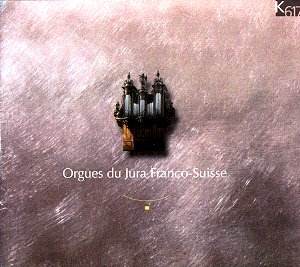






BUY NOW
Triple CD Set
CD 1: Organ works by: - Jehan TITELOUZE (1563-1633): 1. Exultet Coelum 1er verset, 2. Exultet Coelum 2ème verset, 3. Exultet Coelum 3ème verset, - Louis COUPERIN (1626-1661): 4. Ave Maris Stella, 5. Ave Maris Stella en trio, 6. Ut queant laxis, 7. Fantaisie sur le Pange lingua, 8. Pange lingua, 9. Fantaisie sur une basse de trompette, 10. Duo de tierce, 11. Fantaisie à 4, 12. Symphonie, - Nicolas LEBÈGUE (1631-1702): 13. Cromorne en taille, -Franz TUNDER (1614-1667): 14. Praeludium, 15. Choral ‘Christ lag in Todesbanden’, Dietrich BUXTEHUDE (1637-1707): 16. Choral ‘Mensch, willt du leben seliglish’ (BuxWV 206), 17. Choral ‘Ich ruf zu dir, Herr Jesu Christ’ (BuxWV 196), 18. Passacaglia (BuxWV 161), Nicolas LEBÈGUE : 19. Prélude du 1er ton, Louis MARCHAND (1669-1732): 20. Quatuor, 21. Tierce en taille, 22. Fond d’ orgue, 23. Dialogue. [72:41]
Etienne Baillot and Jacques Béraza, Organists
Organ by: K.Riepp, 1754, Reconstructed by P. Hartmann from 1958, Dole Collegiate, France
CD 2: Extraits des deux Livres pour orgue de Jacques BOYVIN (1649-1706): -Suite du 1er ton: 1. Grand plein jeu continu, 2. Fugue grave sur les anches, 3. Duo sur la tierce, Récit tende pour le nazard, 5. Grand Dialogue à choeurs, sur les grands jeux, -Suite du 7è ton: 6. Voix humaine, 7. Basse de trompette, -Suite de 3è ton: 8. Prélude sur le plein-jeu, 9. Dessus de petite tierce, 10. Concert de flutes, 11. Cromorne en taille, -Suite du 5è ton: 12.Grand Prèlude avec les pédalles de trompettes meslées, 13. Récit de cornet, 14. Duo sur le cornet et la trompette 15. Tierce en taille, -Suite du 4è ton: 16. Prélude en fond d’ orgue, 17. Fugue chromatique, 18. Dialogue en fugue, -Suite du 6è ton: 19. Plein jeu à deux choeurs, 20. Trio pour la pedalle, sur les flûtes, 21. Fugue-quatuor, -Suite du 2è ton: 22. Dialogue de récits, cromorne et tierce, 23. Dialogue sur les grands jeux, à 2 choeurs, 24. Trio à deux dessus, -Suite du 8è ton: 25. Grand dialogue à trois choeurs, sur les grands jeux, -26 to 35:Noëls français à Orgelet: Nicolas LEBÈGUE (1631-1702) : 26. Une Vierge Pucelle (Choeur), 27. Une Vierge Pucelle (Orgue), 28. Noël pour l’amour de Marie (Choeur), 29. Noël pour l’amour de Marie (Orgue), Jean-François DANDRIEU (1682-1738): 30. Nous sommes en voie (Choeur), 31. Nous sommes en voie (Orgue), Michel CORRETTE (1709-1795): 32. Vous qui désirez sans fin (Choeur), 33. Vous qui désirez sans fin (Orgue), 34. A minuit fut fait un réveil (Choeur), 35. A minuit fut fait un réveil (Orgue). [71:21]
Francois Delor and Daniel Meylan, Organists
Organs by: -M. Carouge, 1721, St.-Cyr and St. Juliette of Champagnole, Champagnole, France, -J. M. Baffert (?), 1627-1630, Completed by M. Carouge, 1724, Restored by B. Aubertin, 1985, Notre Dame de l’ Assomption of Orgelet, Orgelet, France.
CD 3: Organ works by: - Jean-François DANDRIEU (1682-1738): 1. Offertoire en la mineur, - Jacques BOYVIN (1649-1706): 2. Tierce en taille, - Dietrich BUXTEHUDE (1637-1707): 3. Preludium en ré majeur (BuxWV 139), 4. Choral ‘Durch Adams Fall ist ganz verderbt’ (version vocale harmonisée par Schein), 5. Choral ‘Durch Adams Fall ist ganz verderbt’ (BuxWV 183), 6. Choral ‘Komm, heiliger geist, Herre Gott’ (version vocale d’ après le Livre d’ Erfurt), 7. Choral ‘Komm, heiliger geist, Herre Gott’ (BuxWV 199), Jean-Sébastien BACH (1685-1750): 8-10. Concerto en la mineur (BWV 593),- Georg BÖHM (1661-1733): 11. Choral ‘Vater unser im Himmelreich’ (version vocale d’ après le Livre de Weimar), 12. Choral ‘Vater unser im Himmelreich’, 13. Choral ‘Von Himmel hoch, da komm’ ich her’ (version vocale harmonisée par Pretorius ici transposée 1 ton au dessus), 14. Choral ‘Von Himmel hoch, da komm’ ich her’, 15. Prélude et fugue en ut majeur, Françs DAGINCOUR (1684- 1758): 16-21.Suite du 6ème ton: -Plein jeu, -Duo, -Récit de nazard, -Basse de cromorne, -Trio, -Dialogue, Michel CORRETTE (1709-1795): 22. Offertoire en la majeur. [56:37]
Organ by: Richard Nicole, 1991, Sentier Church, Vallée de Joux, Switzerland
Recorded: 1999